- Home
- Cultivation for soil health, cereal crop rooting and yield
Cultivation for soil health, cereal crop rooting and yield

Cultivation for soil health, cereal crop rooting and yield
As climate change may reduce UK summer rainfall at a critical growth stage for cereal crops, we look at whether different cultivation systems can improve soil health and crop rooting. The trial is part of our Strategic Cereal Farm West programme.
Impact of cultivation systems on soil health and crop roots – trial summary
- Start: 28 September 2020
- End: Harvest 2021
Objective
To determine the impact of cultivation system on soil health, crop rooting and yield.
Why are we testing cultivation systems on soil health, crop rooting and yield?
Research has shown that at 40 cm deep in the soil, wheat doesn't have the root length density for plants to take up water. Wheat roots may grow more in the surface soil and not get deep into the soil profile to access subsoil water. UK climate change predictions are that summer rainfall will reduce. In cereal crops, this will happen at a critical growth stage for flowering and grain fill.
UK farmers and agronomists need to develop practical solutions to this problem. This trial tests whether cultivation can improve soil health and improve crop rooting.
How are we testing the impact of cultivation systems?
The replicated tramline trial is in Field 15 (16 hectares) in Graham winter wheat. Strategic Cereal Farm West host, Rob Fox, drilled the trial using a tine seed drill on 28 September 2020 at a rate of 171 kg/ha. The soil type is clay.
There are four establishment treatments in the trial:
- Direct drilling
- 5 cm depth: disc cultivator and shallow spring tine before drilling
- 15 cm depth: single pass deep soil disc cultivator and a shallow spring tine before drilling
- 30 cm depth: single pass deep soil disc cultivator and a shallow spring tine before drilling
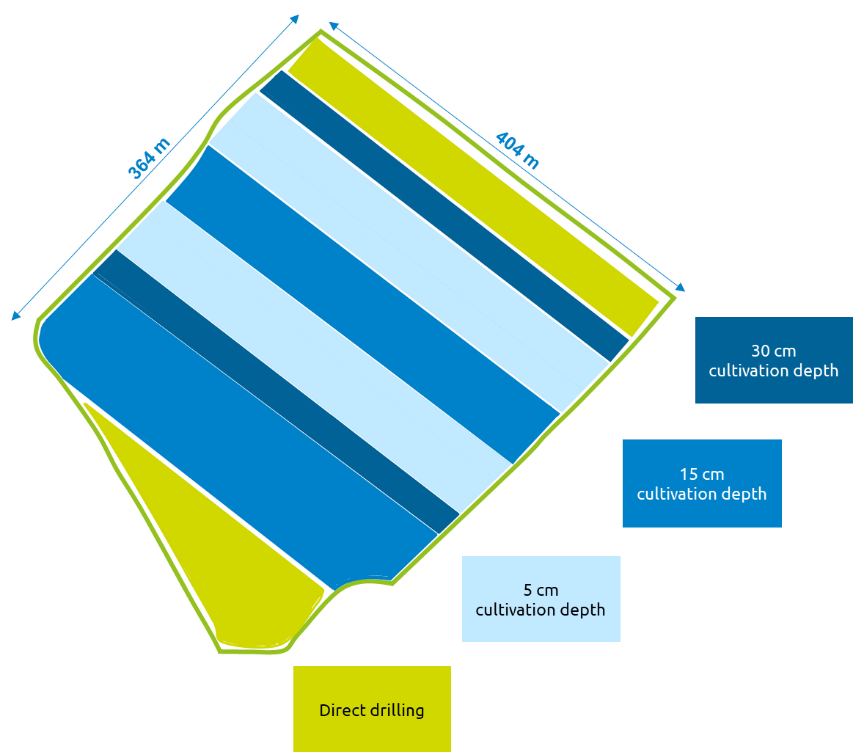
Results from cultivation trial so far
The impact of cultivation on soil
Soil health scorecard
- Mg concentrations were lower in direct drill and 5cm treatments whilst the reverse was true for pH
- There were no other significant differences in nutrients concentrations
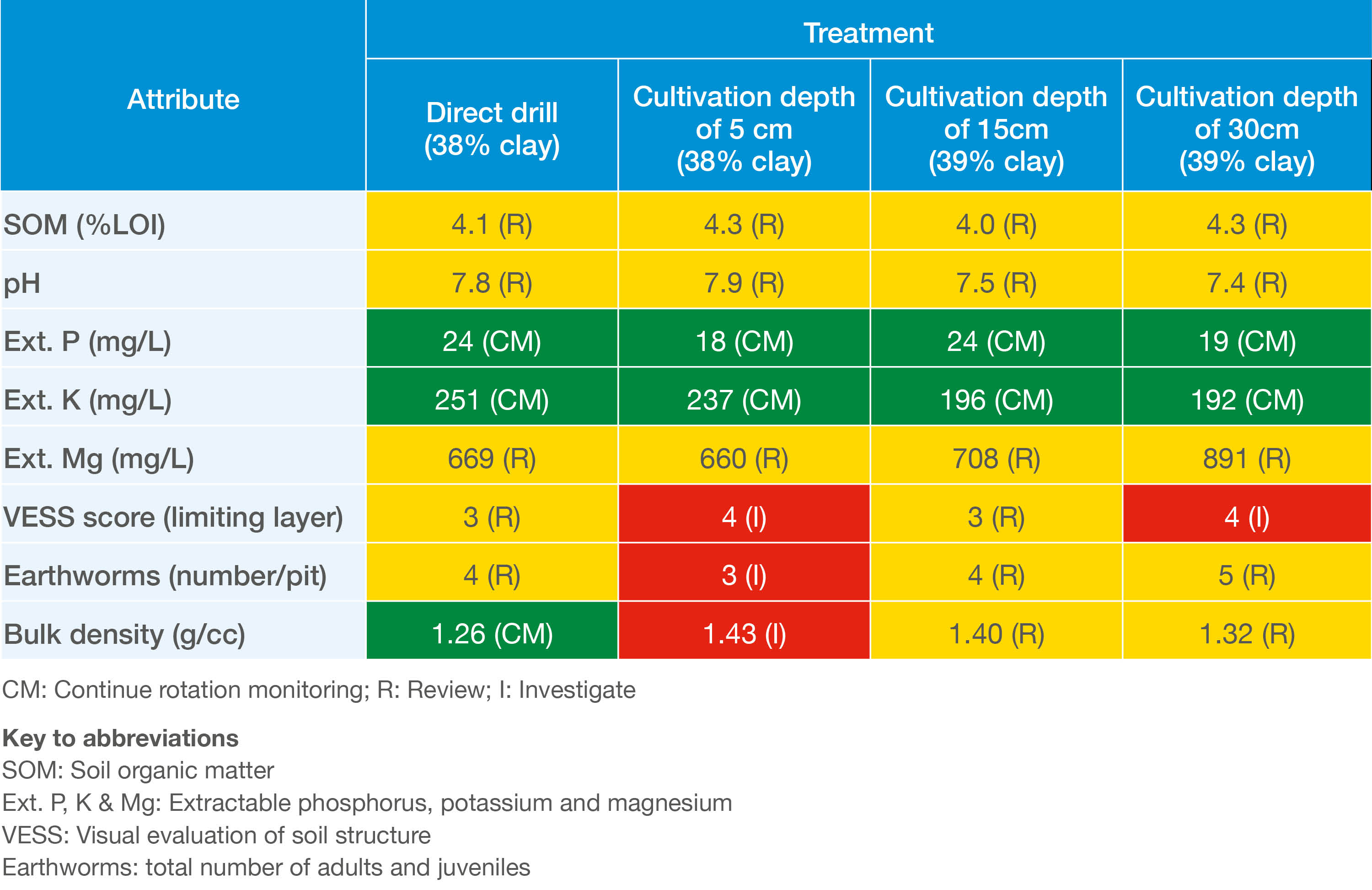
- pH: target pH > 6.5 for arable soils; see ahdb.org.uk/rb209 for specific crop advice
- SOM: ≥ 4 and 5% is ‘typical’ for medium and heavy textured soils, respectively; texture is borderline heavy, so SOM levels are close to typical values
- Soil type: whole field > 35% clay (heavy textured)
- Ext. P, K & Mg: No nutrients were limiting to crop production; Ext. Mg levels were high, reflecting underlying geology.
- VESS: A score of 4 indicates poor soil structure (‘compact’) and 3 indicates moderate soil structure (‘firm’)
- Bulk density: at 5-10cm, thresholds decrease with increasing SOM (benchmark = 1.26 g/cm3 at 4% SOM)
- Earthworms: Total number of adults and juveniles; >8/pit = ‘active’ population for arable soils; < 4/pit = ‘depleted’; low numbers recorded across the field
Since this cultivation trial, the soil health scorecard approach has developed further. See current information on the AHDB soil health scorecard approach
Soil carbon stocks
- Carbon stocks ranged from 63 t/ha to 69 t/ha
- No significant differences between treatments in in the total amount of carbon stocks to 60cm depth
- However, the data suggests a difference in distribution within the profile in the 5cm and direct drill treatments when compared to the deeper cultivations
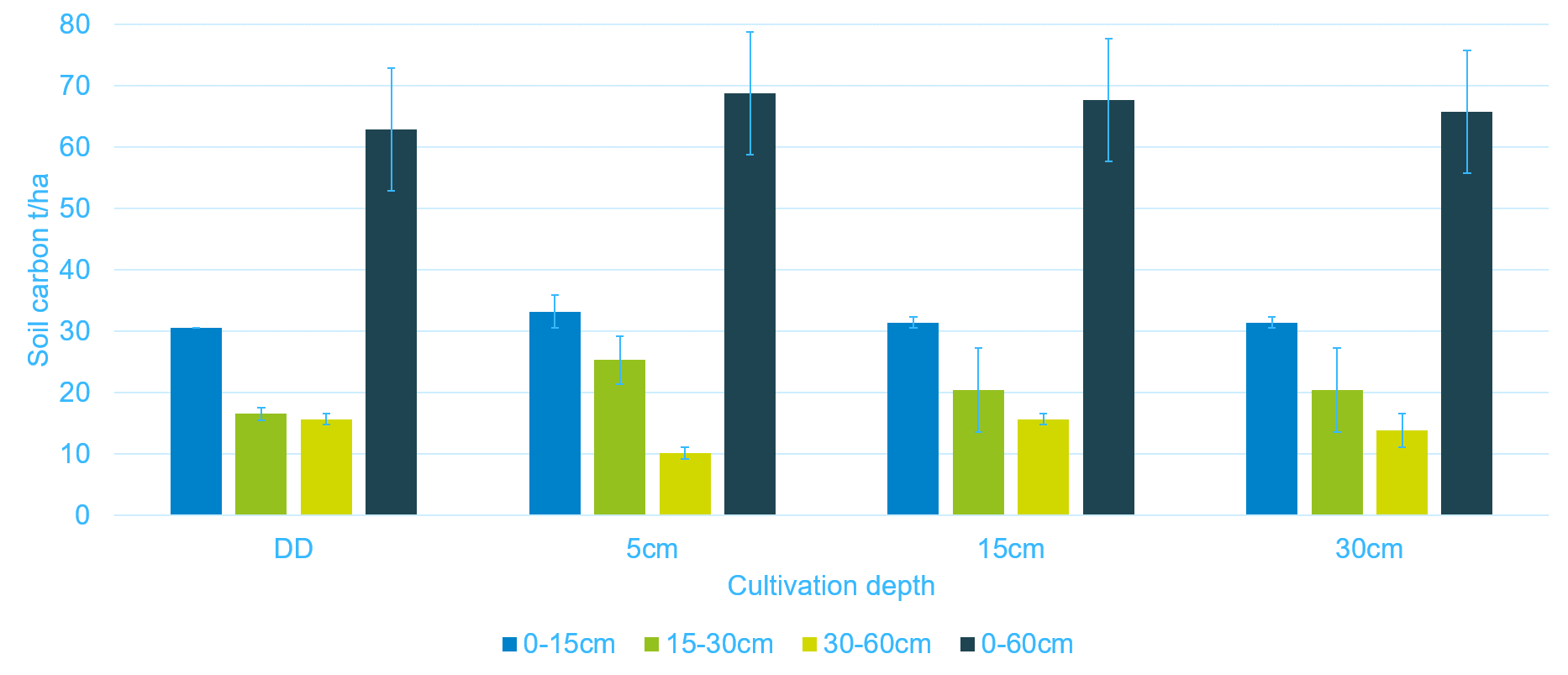
Graph: soil carbon stocks by soil depth
Soil bulk density
- The lowest soil bulk densities were recorded in the direct drill treatment
- In the cultivated treatments, increasing the depth of cultivation from 5 to 30 cm reduced bulk density, but only in the top 15cm of soil
- Bulk density at 10-20cm depth was lower in the direct drill treatment than the 15 and 30cm depth cultivations
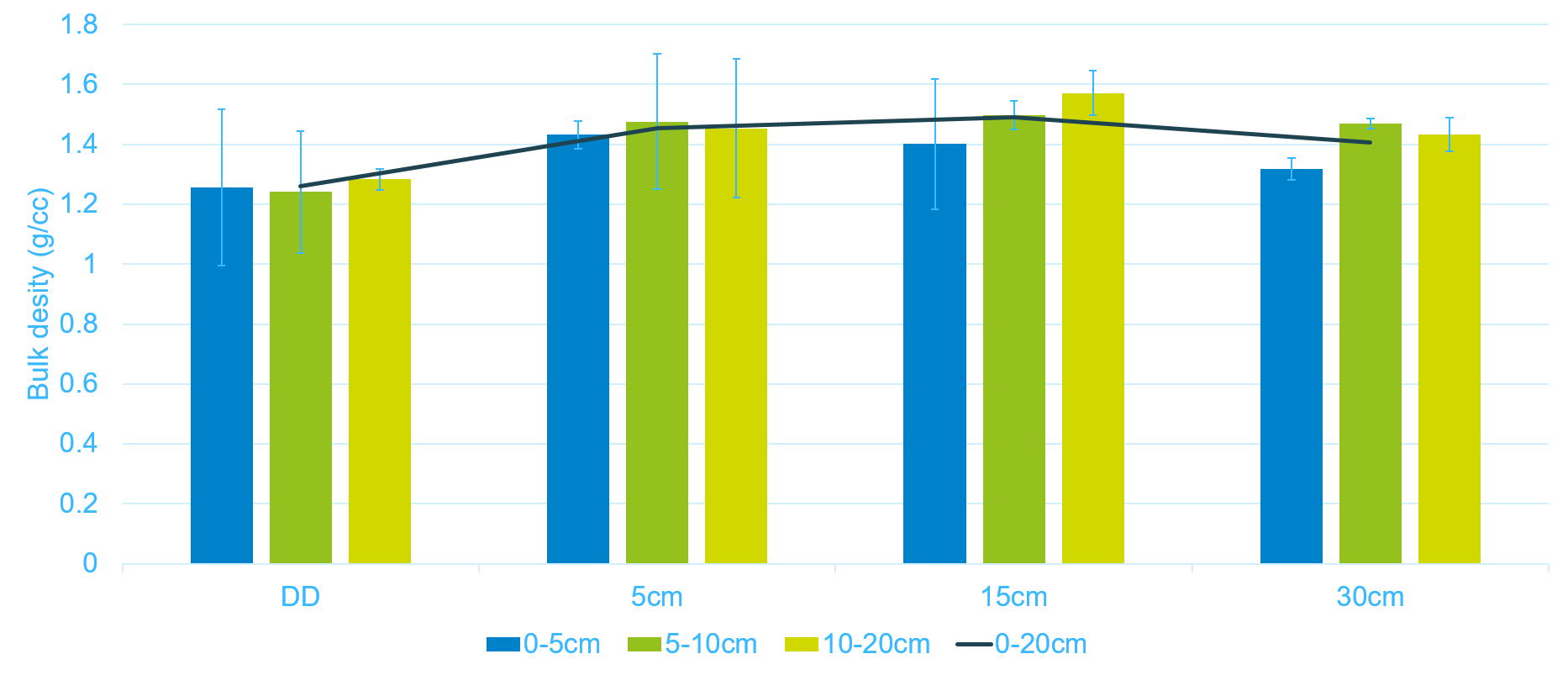
Graph: soil bulk density at three depths according to cultivation depth
Penetrometer resistance
- Penetration resistance was lowest throughout the profile from (10 to 50cm) in the 30cm cultivation treatment
- The 5cm treatment had the highest resistance at 10 to 20cm depth
- At depths greater than 20cm penetration resistance was similar in direct drill, 5cm and 15cm treatments
In autumn 2019, following a failed oilseed rape crop the soil slumped. This data suggests that the 30cm cultivation was most effective in loosening the soil. The lack of soil disturbance in the direct drill treatment may have conferred a degree of resilience in the top 25cm leading to a lower penetration resistance relative to the shallow cultivation treatments.
Typically, resistances of 1.5-2 MPa and above are thought to limit rooting suggesting root limitation at:
- 10 cm and below for the 5cm treatment
- 20cm for direct drill
- 15cm treatments and below 25cm for the 30cm treatment
Penetration resistance for the site was much greater than previous years (0.5-1.6MPa in year 1 and 1.0-2.0 MPa in year 2) and may be the result of structural damage through waterlogging in the previous autumn/winter
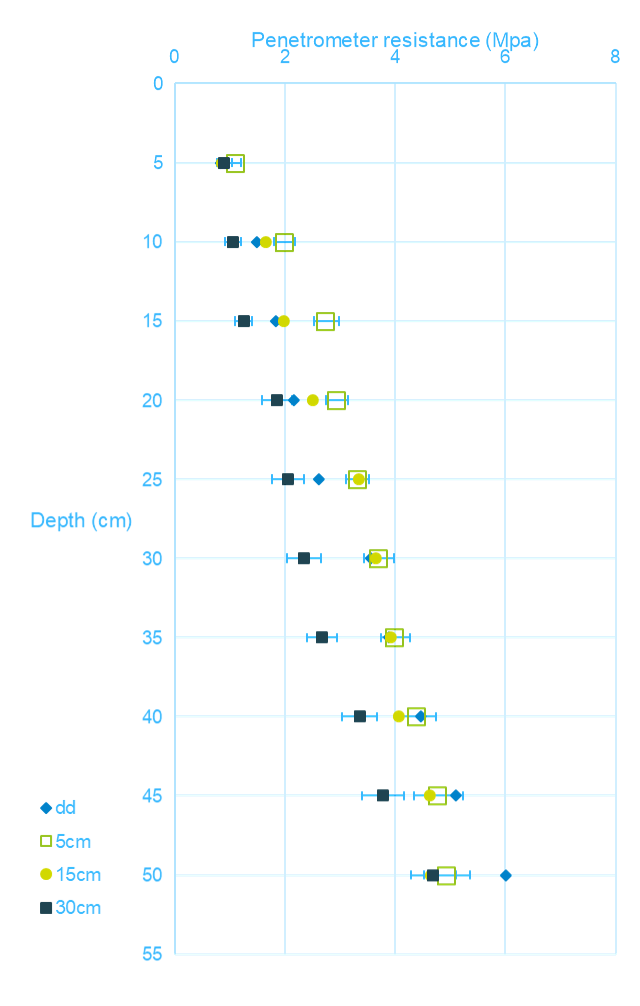
Graph: Penetration resistance to 50cm depth. Error bars shown for 5 and 30cm depth
The impact of cultivation on crops
Establishment
There was a tendency for autumn plant populations to be highest with shallower cultivations. Populations in both direct drill and 5cm treatments were greater than the 30cm treatment. However, the reverse was true of overwinter survival. The spring plant population was lower in the direct drill treatment.
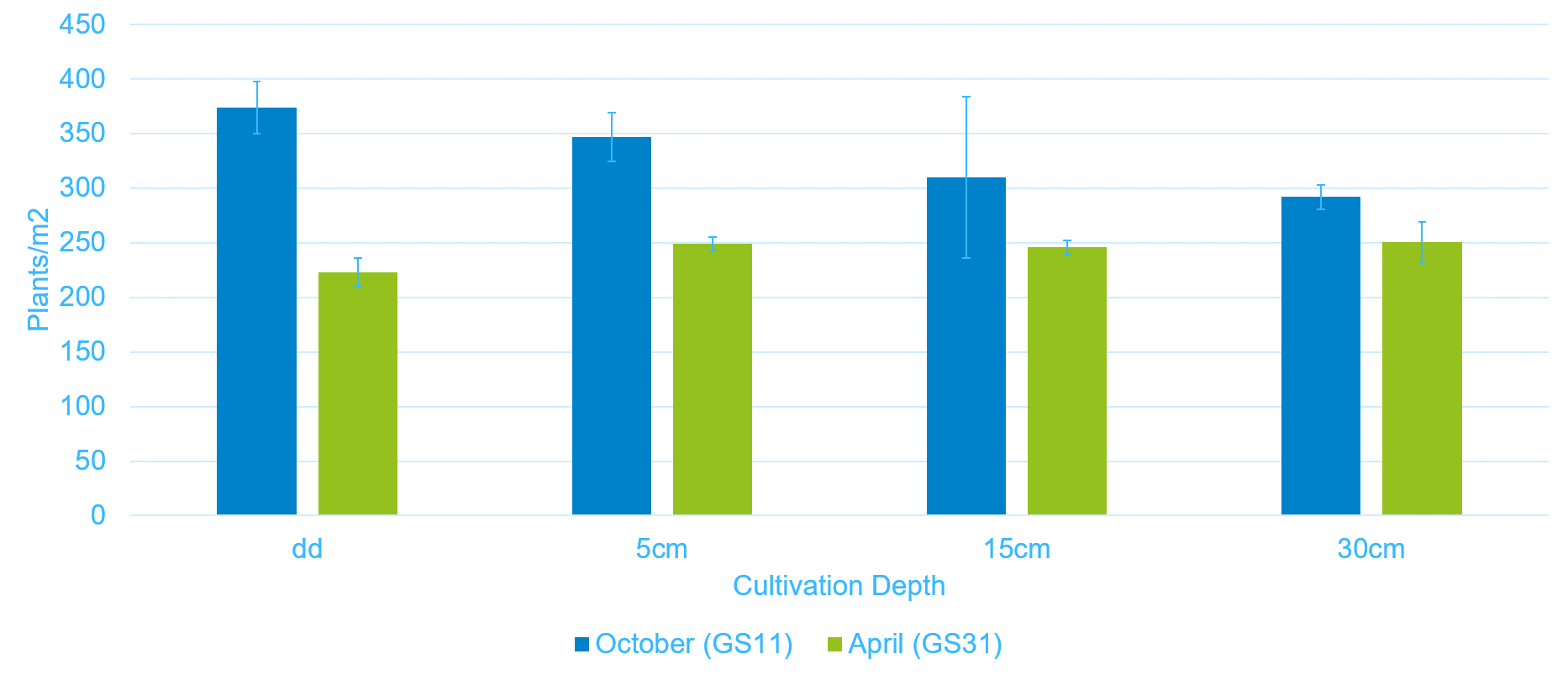
Graph: Autumn and spring plant populations
NDVI
NDVI in the autumn was greatest for the 30cm treatment and lowest under direct drilling. Although plant populations were greatest for the direct drill treatment in the autumn this suggests that these plants were less vigorous than those in other treatments and helps explain the over winter losses.
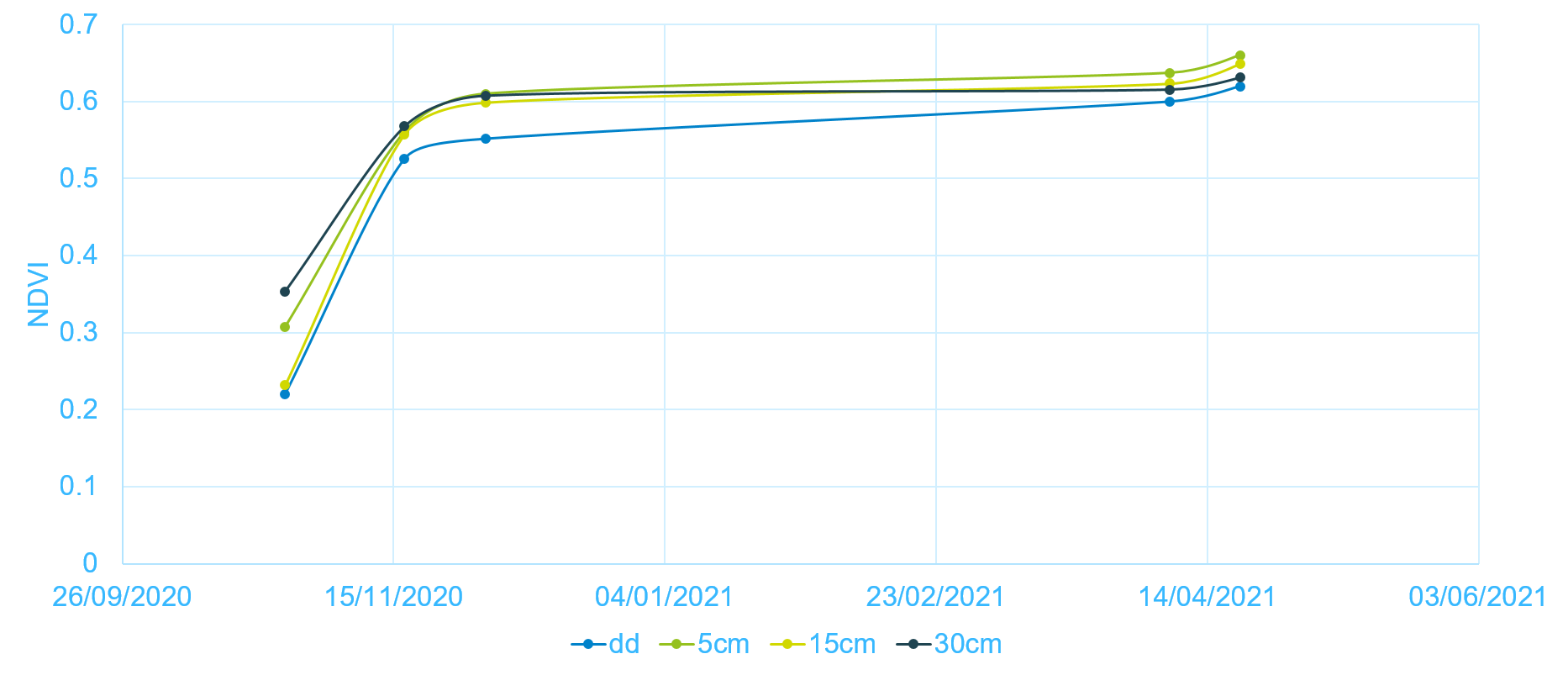
Graph: NDVI
Crop rooting in spring
The maximum root width and depth were less in the direct drill and 5cm cultivation depths, leading to a smaller convex hull, which means that the root systems were not able to explore such a large soil area for nutrients and water.
What is the convex hull?
The convex hull is calculated from the root parameters and is the minimum area enclosing the whole root system
There appeared to be an increase in the branching density (number of lateral roots) in the direct drill treatment which may have provided a degree of compensation. Spring rooting depth and convex correlated well with final yield.
|
|
Direct Drill |
5cm |
15cm |
30cm |
|
Tiller Number |
4.0 |
4.2 |
3.5 |
3.6 |
|
Width at stem base (cm) |
1.1 |
0.9 |
1.0 |
1.0 |
|
Max root width (cm)* |
8.8a |
9.5b |
8.3c |
8.3c |
|
Depth to max root width (cm) |
4.1 |
4.5 |
4.9 |
5.7 |
|
Max root depth (cm)* |
9.0a |
8.2a |
11.2b |
12.3b |
|
Mean root angle 0 |
21.8 |
24.0 |
19.5 |
22.7 |
|
Nodal root number |
18.8 |
14.8 |
15.3 |
14.3 |
|
Seminal root number |
4.3 |
4.3 |
4.2 |
4.2 |
|
Total root number |
23.2 |
19.1 |
19.4 |
18.4 |
|
Branching density (1-5)* |
3.8a |
2.7b |
2.8b |
3.0b |
|
Convex hull (cm2)* |
9.0a |
8.2a |
11.2b |
12.3b |
Deep crop rooting at harvest
The length of roots was assessed in 20cm increments down the profile, post harvest. The results shown in are only for the 40-100cm profile.
There was a tendency for fewer roots in the direct drill and 5cm treatments (especially at 40-60cm depth), but these differences were not statistically significant.
There were very few roots in the 80-100cm depth, and although there appeared to be more in the direct drill treatment, there was more variability between samples so, again this was not significant.
In all cases rooting density was well below the 1cm/cm3 required to fully access water below 40cm.
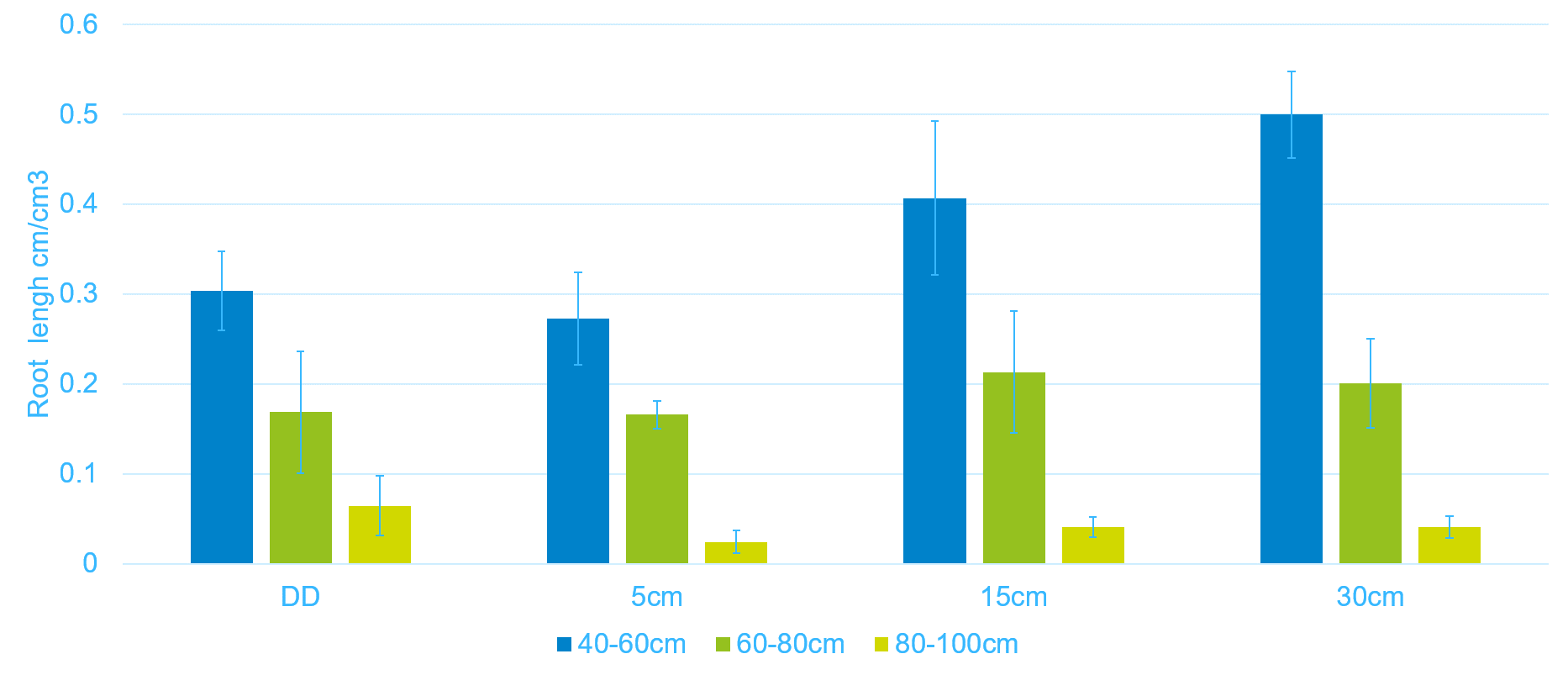
Graph: root length (cm/cm3) in subsoil samples
Crop yield
Method
Yield map data was analysed using ADAS agronomics software. Data was cleaned to remove headlands, locally extreme data points, the untreated areas and any combine runs that spanned both varieties. They were corrected for any offset created by changes in combine direction.
A statistical model was fitted to the data to account for spatial effects along and across rows, and affects were associated with the treatments.
The agronomics software was used to model the effect of the 15cm treatment (standard farm practice) compared to the other cultivation regimes.
Results
The 15cm cultivation treatment yielded 10.92 t/ha.
Increasing the cultivation depth to 30cm had no effect on yield.
Both direct drill and 5cm treatments reduced yield by approximately 0.5t/ha compared to the other treatments (significant at 90% and 95% confidence respectively).
Year 1 results showed a similar reduction in yield from the 5cm treatment (0.44t/ha) with the deep cultivation also reducing yield (0.77t/ha), although this was not statistically significant.
|
Cultivation Depth |
Mean yield (t/ha) |
Yield response compared to 15cm cultivation (normal farm practice) |
|
15cm |
10.92 |
|
|
Direct drill |
|
-0.51 ± 0.288 (LSD 0.565) |
|
5cm |
|
-0.539 ± 0.248 (LSD 0.486) |
|
30cm |
|
-0.098 ± 0.286 (LSD 0.560) |
Further information
Results from the 2019 cultivation trials
Results from the 2020 cultivation trials
Further information about our soils research and resources
Our Strategic Farms are an opportunity to see how to use our research on a commercial farm. Find out more about our Strategic Cereal Farm West Programme

